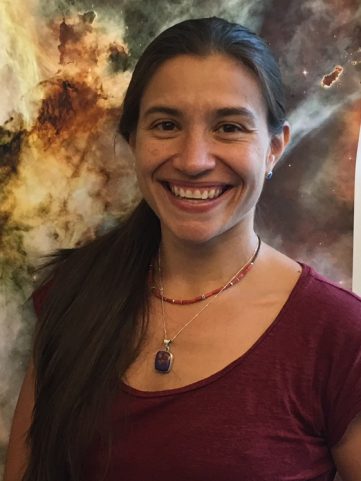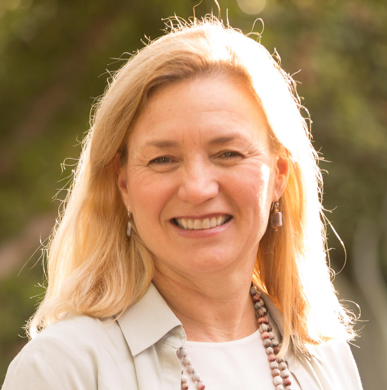It’s called Flip learning and two Bryn Mawr profs are using it in class
By Nicole Gildea
While most breakthroughs in science were discovered in the lab, one recent breakthrough has its origins in an unlikely place, the classroom.
Many science teachers across America are revolutionizing the way they teach by using a new educational model called flipped learning. In a flipped classroom, the lecture part of class becomes homework while the homework part becomes classwork. This happens when teachers make their students learn course material first outside of class. Then in place of a traditional lecture, class time is devoted to written work and to problem solving.
Two physics professors at Bryn Mawr College have adopted this model. One is Kate Daniel.
“I firmly believe in learning by doing,” she said.

Professor Kate Daniel
Students in her statistical mechanics and thermodynamics class are assigned reading for homework to introduce them to new topics. They collaborate in class to discuss these topics and to solve problems from the textbook. Daniel says this is when real learning occurs.
Carl Weiman, the 2001 recipient of the Nobel Prize in Physics, helped popularize the idea of the flipped model after making an appearance on NPR this year.
“You give people lectures, and some students go away and learn the stuff,” he said. “But it wasn’t that they learned it from lecture — they learned it from homework, from assignments. When we measure how little people learn from an actual lecture, it’s just really small.”
More teachers are beginning to flip their classrooms because it helps their students learn better. Scott Freeman, a lecturer at the University of Washington, flipped his introductory biology class to help improve a 17 percent failure rate, The Seattle Times reported in 2012. The course’s failure rate dropped to 4 percent, and the number of students earning A’s increased from 14 percent to 24 percent.
Professor Elizabeth McCormack first introduced flipped learning to Bryn Mawr in 2012 after wanting more time to work on group problem solving with her students.
“One of the challenges of teaching physics is you’re often teaching concepts in physics to students at the same time you’re using a mathematical language,” she said. “It’s difficult to learn two things at once.”
She flipped her electromagnetism class as a result. Here is an overview of how it ran: Students were introduced to concepts outside of class through weekly reading and podcast assignments. They spent class time mastering the mathematical skills related to those concepts by solving problems.
Not all her students were thrilled at first with this new method. Some even came to her office hours asking for extra lectures because they felt they were not learning in class.
“What they were really telling me was that they needed more opportunity to talk about the material, to talk about the challenging pieces,” said McCormack.
The flipped model enabled her to tailor her class to fit the needs of her students. More class time was devoted to focusing on the material that students were struggling with the most. McCormack served as a cognitive coach this way, clarifying concepts and guiding students through the most challenging problems.
Lectures have been the traditional way of teaching STEM classes before the flipped model. Many students however dislike lectures because they do not encourage class discussion and participation. Tahawney Terrell, a junior, entered Bryn Mawr thinking she would major in biology but decided to major in sociology.
“I just find my sociology classes more interesting,” Terrell said.
“About 60 percent of students who enroll in a STEM field switch to a non-STEM field or drop out,” according to a 2015 article, “Why We Are Teaching Science Wrong, and How to Make It Right,” published by Nature. “That figure is roughly 80 percent for those from minority groups and for women.”
Flipped classrooms are gaining popularity because they offer a solution to the problem.

Professor Elizabeth McCormack
According to a 2013 study by the Flipped Learning Network, of 450 teachers using a flipped model, 66 percent reported higher standardized test scores and 80 percent perceived an improvement in students’ attitude towards learning. The flipped model helps retain more students in STEM by increasing students’ grades and attitudes toward science.
“It works well for technical courses,” said Clare Allsopp-Shiner, a junior at Bryn Mawr. “Applying concepts to figure things out in class really helps cement my understanding.”
Daniel’s physics class at Bryn Mawr is lively and interactive. Her students bounce ideas off each other and work to tackle complex problems. All the while she never stops to lecture in front of the blackboard. She instead walks around the room to see how students are doing and to answer questions.
Daniel and McCormack’s flipped classes are two of the many classes on camps that have embraced blended learning, which combines self-paced learning and face-to-face classroom instruction. President Kim Cassidy announced at the 2014 Blended Learning in the Liberal Arts
Conference that all faculty who participated in the pilot blended learning program have continued using a blended approach in their teaching.
Although not all the blended learning classes at Bryn Mawr have flipped classrooms, flipped classrooms have a positive presence on campus and are becoming more widespread.
“My experience with flipped learning in a second-year physics course was frankly, disorienting, but in the best sense of the word,” McCormack said. “It’s something I plan to stick with.”
